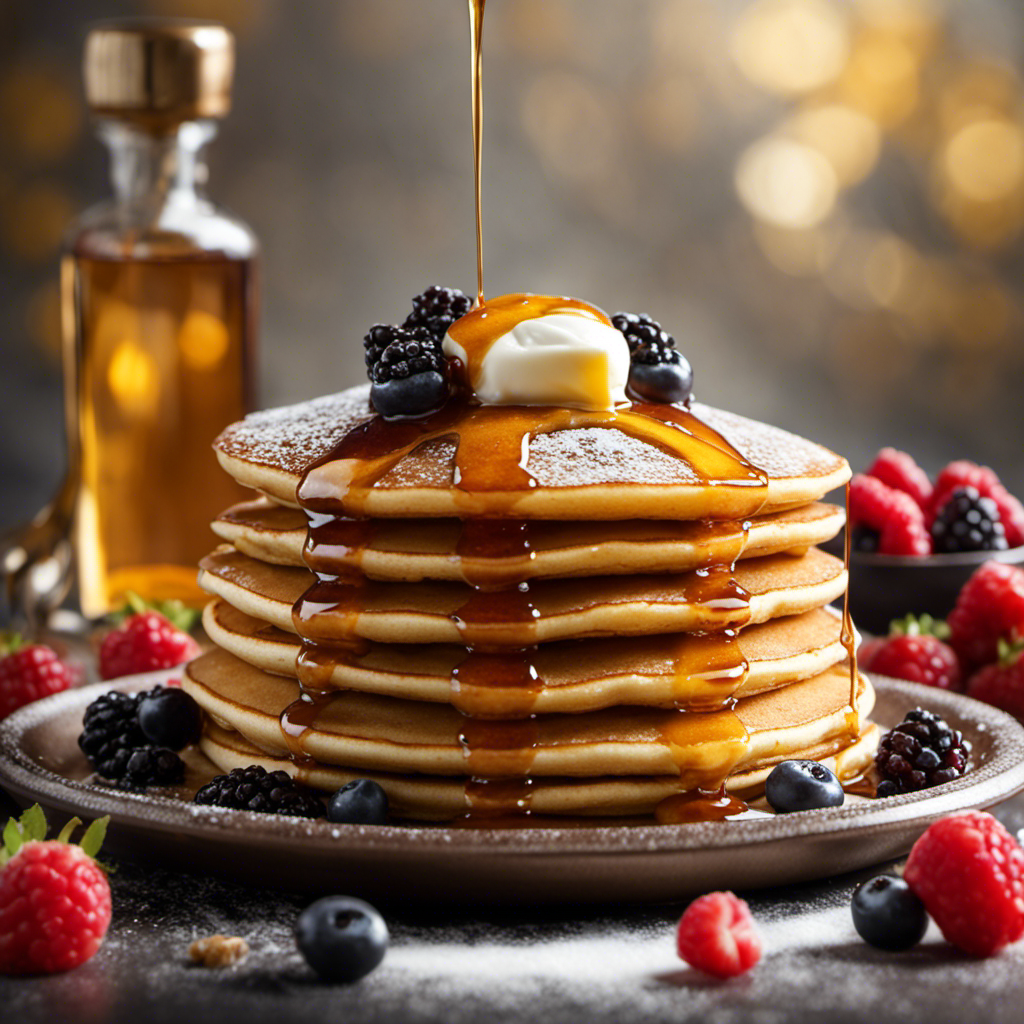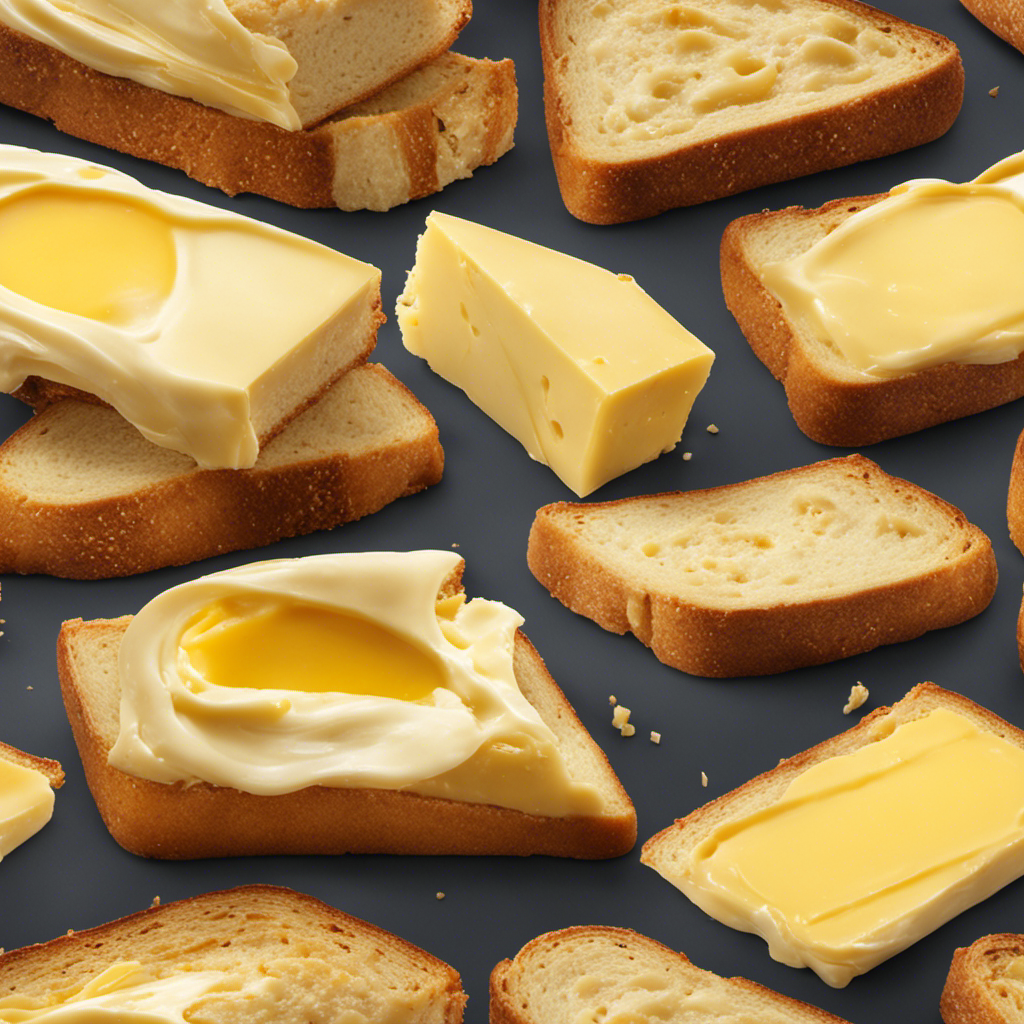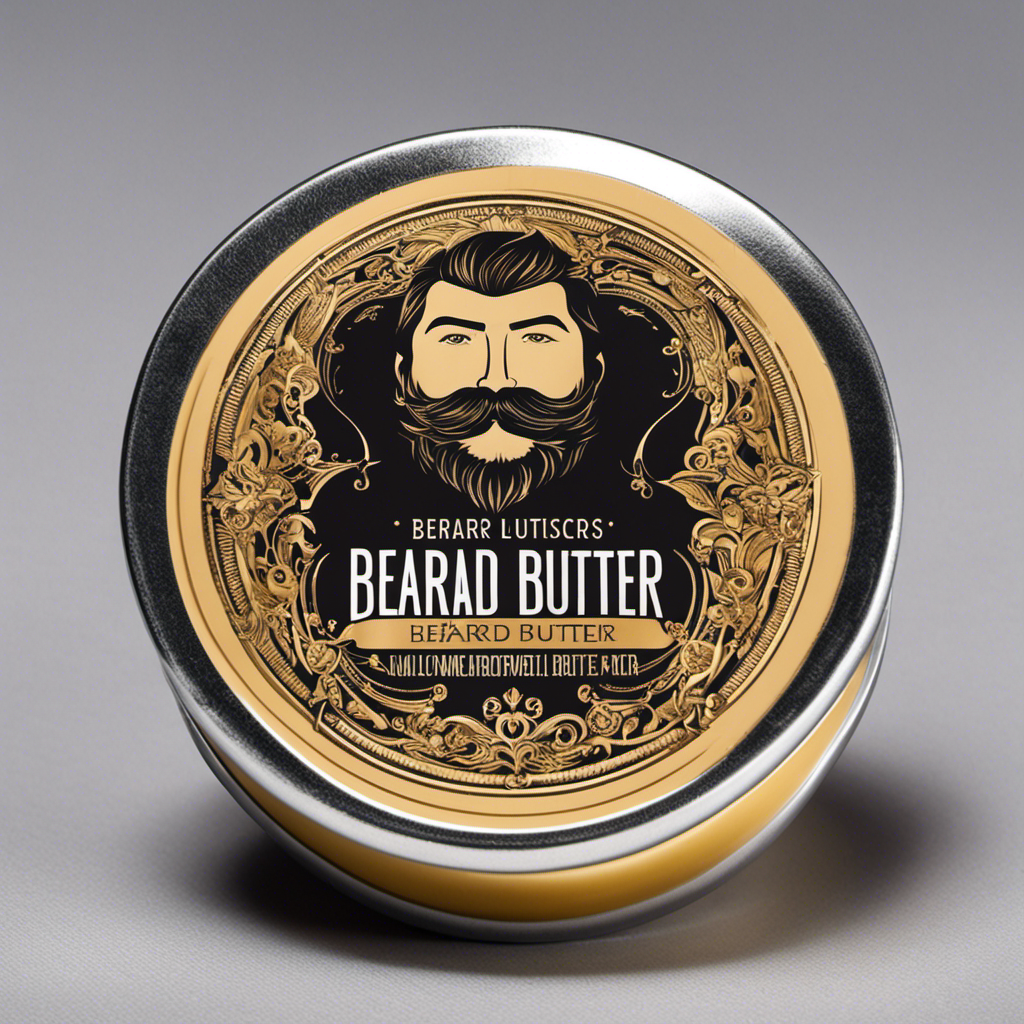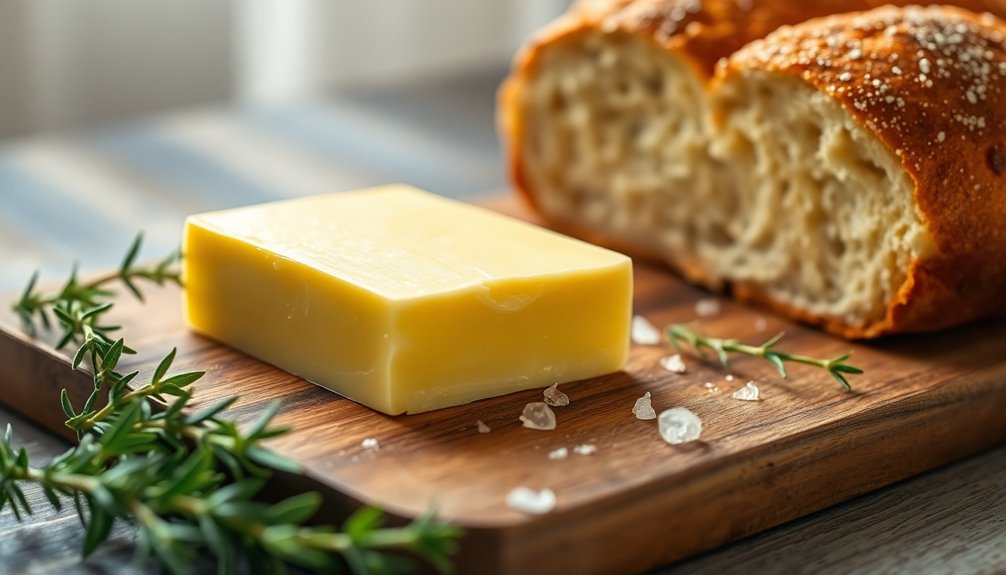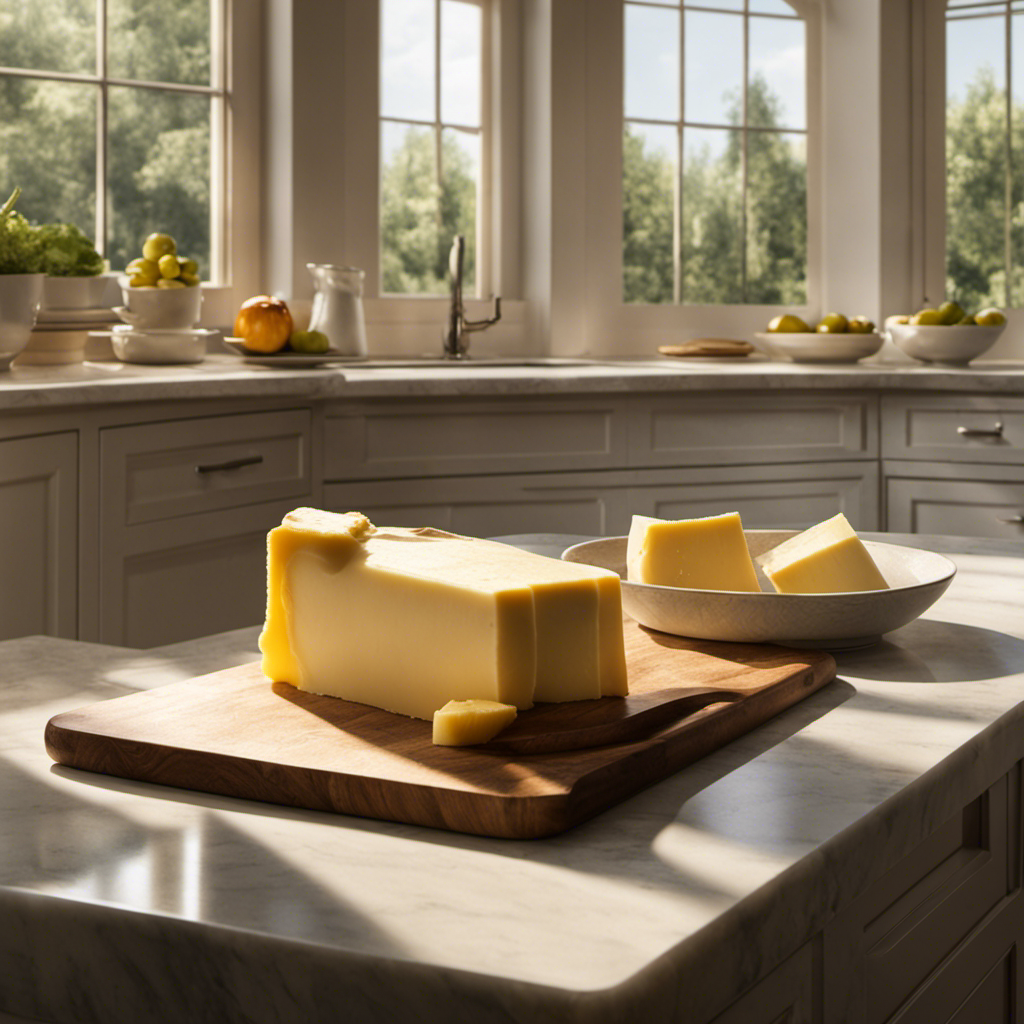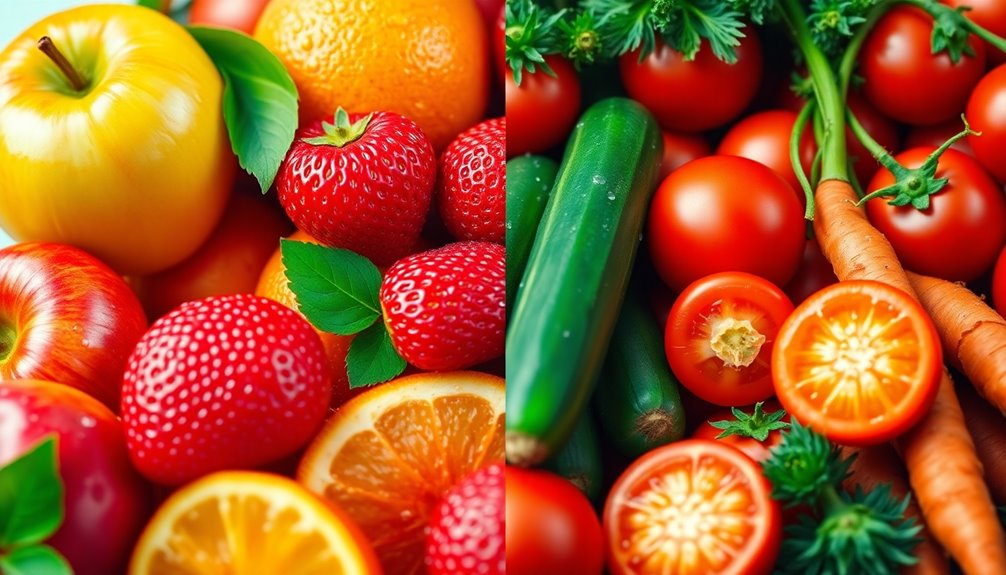I have always agreed with the saying ‘butter makes everything better.’ However, have you ever tried whipped butter? It truly transforms the culinary experience.
From baking to cooking to spreading on toast, whipped butter adds a light and fluffy texture that enhances any dish. Not only that, but it’s also perfect for topping pancakes, waffles, and even using in pastries and desserts.
And the versatility doesn’t stop there – whipped butter can be incorporated into sauces, dressings, and homemade spreads.
Get ready to elevate your culinary creations with the wonders of whipped butter.
Key Takeaways
- Whipped butter can be used in baking to adjust the fat content and achieve lighter and fluffier textures in baked goods.
- It is a versatile ingredient that can be incorporated into various recipes such as creamy pasta sauces, sautéed vegetables, mashed potatoes, and scrambled eggs for added richness and flavor.
- Spreading whipped butter on toast enhances the flavor and adds a creamy, velvety texture. It is also a good source of healthy fats.
- Whipped butter can be used as a topping for pancakes and waffles, adding a light and fluffy texture and enhancing the flavor and presentation of breakfast favorites.
Baking With Whipped Butter
When baking with whipped butter, it’s important to adjust the amount of fat in the recipe. Whipped butter has a lower fat content than regular butter, which means it has less moisture and can affect the texture and structure of baked goods.
To compensate for this, I recommend adding a little extra whipped butter or another source of fat, such as oil or cream, to ensure your baked goods turn out moist and tender. Additionally, keep in mind that whipped butter may have a slightly different flavor profile, so you might want to adjust your recipe accordingly.
When using whipped butter in baking, it’s also a good idea to let it come to room temperature before incorporating it into your recipe, as this will help with its creaming ability.
Overall, baking with whipped butter can yield delicious results, so don’t be afraid to experiment with different recipe ideas!
Cooking With Whipped Butter
If you’re cooking with it, you’ll find that whipped butter adds a creamy richness to your dishes. Here are some ways you can incorporate whipped butter into your cooking:
-
Whipped butter in creamy pasta sauces: Add a dollop of whipped butter to your pasta sauce for a velvety smooth texture and a luxurious taste.
-
Whipped butter in sautéed vegetables: Use whipped butter instead of regular butter or oil when sautéing vegetables. It adds a rich flavor and helps to create a delicious caramelized crust on the veggies.
-
Whipped butter in mashed potatoes: Whip some butter into your mashed potatoes for an extra creamy and indulgent side dish.
-
Whipped butter in scrambled eggs: Incorporate whipped butter into your scrambled eggs for a silky texture and a buttery taste.
-
Whipped butter in baked goods: Use whipped butter in your baking recipes to achieve a lighter and fluffier texture.
Cooking with whipped butter enhances the taste and texture of your dishes, making them more enjoyable and satisfying.
Now, let’s move on to another delightful use of whipped butter: spreading it on toast.
Spreading Whipped Butter on Toast
Spreading whipped butter on toast creates a deliciously creamy and indulgent breakfast treat. Not only does it enhance the flavor of the toast, but it also adds a velvety texture that melts in your mouth. And the best part? Whipped butter can actually have some health benefits too. It is a good source of healthy fats, which can help improve cholesterol levels and support brain function. Additionally, whipped butter contains essential vitamins like Vitamin A and Vitamin D. When it comes to variations, there are endless possibilities. From savory options like garlic and herb whipped butter to sweet options like cinnamon sugar or honey whipped butter, there’s something for everyone’s taste buds. So go ahead, spread some whipped butter on your toast and savor the deliciousness while reaping the health benefits.
| Variation | Description |
|---|---|
| Garlic and Herb | Infused with garlic and aromatic herbs |
| Cinnamon Sugar | Sprinkled with a sweet cinnamon sugar |
| Honey | Sweetened with a drizzle of honey |
| Chipotle Lime | Spiced up with smoky chipotle and lime |
Whipped Butter as a Topping for Pancakes and Waffles
When it comes to topping pancakes and waffles, whipped butter is the perfect choice. Its light and fluffy texture adds a delightful creaminess to every bite.
Not only does it enhance the flavor of these breakfast favorites, but it also adds a touch of elegance to their presentation.
Light and Fluffy Texture
To achieve a light and fluffy texture, you can whip the butter until it becomes creamy and airy. Whipped butter is a versatile and convenient ingredient that can be used in various recipes. Here are some benefits of using whipped butter:
-
Spreadability: Whipped butter is easier to spread on bread, muffins, or pancakes, thanks to its light and airy consistency.
-
Quick melting: The whipped texture allows the butter to melt faster, making it ideal for cooking and baking.
-
Enhanced flavor absorption: Whipped butter absorbs flavors more efficiently, making it a perfect choice for adding a burst of taste to your dishes.
-
Smooth texture: Whipped butter blends seamlessly into sauces and dressings, creating a smooth and velvety texture.
-
Improved presentation: Whipped butter can be easily piped or shaped, adding an elegant touch to your culinary creations.
Using whipped butter not only enhances flavor and presentation but also adds a delightful lightness to your dishes.
Enhances Flavor and Presentation
After discussing the light and fluffy texture of whipped butter in the previous subtopic, let’s now explore how it enhances the flavor and presentation of dishes. Whipped butter’s creamy consistency and delicate taste make it a versatile ingredient that can be used in various recipes to elevate their overall appeal. Its smooth texture allows it to blend seamlessly with other ingredients, providing a rich and buttery flavor to both sweet and savory dishes. Additionally, whipped butter can be easily incorporated into sauces, spreads, and dressings, enhancing their taste and adding a luxurious mouthfeel. To further emphasize the benefits of using whipped butter, consider the following table:
| Benefit | Description |
|---|---|
| Enhances Flavor | Whipped butter adds richness and depth to dishes |
| Versatility in Recipes | It can be used in a wide range of recipes, from baked goods to savory dishes |
| Creamy Texture | The smooth consistency of whipped butter enhances the overall mouthfeel of dishes |
| Improved Presentation | Its light and fluffy texture gives dishes an attractive and professional appearance |
With its ability to enhance flavor and presentation, whipped butter is an excellent choice for elevating the taste and appearance of various dishes. Now, let’s delve into the next subtopic: using whipped butter in pastries and desserts.
Using Whipped Butter in Pastries and Desserts
When it comes to using whipped butter in pastries and desserts, there are two key points to consider: enhanced flavor profiles and creamy texture benefits.
Whipped butter has a light and airy consistency, making it easier to incorporate into batters and doughs, resulting in a smoother and more uniform texture.
Additionally, the process of whipping butter adds air, which enhances its flavor and makes it more pronounced in baked goods.
Enhanced Flavor Profiles
For even more delicious flavor profiles, try using whipped butter on your favorite dishes. Whipped butter is not only a versatile ingredient, but it also enhances the taste of various dishes.
Here are five ways that whipped butter can elevate your meals:
- Spread it on freshly baked bread for a creamy and rich flavor.
- Melt it over grilled vegetables to add a luscious and savory element.
- Use it as a base for sauces and gravies, creating a velvety smooth texture.
- Incorporate it into mashed potatoes for an extra creamy and indulgent side dish.
- Top your pancakes or waffles with whipped butter for a delectable breakfast treat.
Whipped butter is a game-changer when it comes to enhancing the taste of your favorite dishes. Its smooth and airy texture allows for easy incorporation into various recipes, making it a must-have ingredient in your kitchen.
Creamy Texture Benefits
Now that we’ve explored how whipped butter enhances flavor profiles, let’s dive into its creamy texture benefits.
Baking with whipped butter is a game-changer, as it creates a lighter and fluffier texture in baked goods. The air incorporated during the whipping process gives cakes, cookies, and pastries a tender and melt-in-your-mouth consistency.
Whipped butter also makes spreading easier, allowing for a more even distribution on toast, muffins, and bagels.
In cooking, using whipped butter can elevate your dishes to new heights. Its creamy texture blends effortlessly into sauces, enhancing their richness and smoothness. Whether you’re making a creamy pasta sauce or a velvety soup, using whipped butter can take your culinary creations to the next level.
Additionally, whipped butter adds a luxurious touch to mashed potatoes, giving them a light and fluffy texture that is simply irresistible.
Whipped Butter in Sauce and Gravy Recipes
Whipped butter can add a creamy richness to sauce and gravy recipes. Its light and fluffy texture makes it easy to incorporate into various dishes, enhancing their flavor and mouthfeel.
Here are some ways whipped butter can elevate your cooking:
-
Whipped butter in pasta dishes: Adding a dollop of whipped butter to cooked pasta can create a luxurious and velvety sauce. The butter melts effortlessly, coating each strand of pasta, resulting in a luscious and indulgent meal.
-
Whipped butter in mashed potatoes: Whipped butter can transform ordinary mashed potatoes into a velvety and creamy side dish. Its airy consistency blends seamlessly with the potatoes, adding a rich and smooth texture that is sure to impress.
Whipped Butter in Salad Dressings and Marinades
Adding whipped butter to salad dressings and marinades can enhance the flavor profiles of your dishes. It imparts a creamy and smooth texture, adding richness and depth to culinary creations. Whipped butter provides a velvety mouthfeel and helps bind the ingredients together in salad dressings, resulting in a cohesive and luscious dressing. It also adds a subtle buttery taste that complements a variety of salad ingredients.
In marinades, whipped butter acts as a tenderizer and adds a luxurious touch to meats, poultry, and seafood. The whipped nature of the butter allows it to melt easily, infusing the marinade with its rich flavor. This helps create succulent and flavorful dishes.
Whipped Butter in Homemade Flavored Butters and Spreads
When you incorporate whipped butter into your homemade flavored butters and spreads, you’ll create irresistible combinations that elevate your dishes to new levels of deliciousness. Whipped butter is a versatile ingredient that adds richness and creaminess to any recipe.
Here are some flavored butter variations you can try:
- Garlic and herb butter: Perfect for spreading on bread or melting over grilled vegetables.
- Honey cinnamon butter: A sweet and spicy combination that pairs well with pancakes or toast.
- Lemon dill butter: Adds a refreshing twist to seafood dishes or roasted potatoes.
- Chipotle lime butter: Gives a smoky and tangy kick to grilled meats or corn on the cob.
- Maple pecan butter: A decadent treat for waffles or baked goods.
In addition to their delicious flavors, whipped butters also offer health benefits. They are a good source of healthy fats, vitamins, and minerals. Whipped butter contains conjugated linoleic acid (CLA), which has been linked to potential weight loss and improved heart health.
Frequently Asked Questions
Can Whipped Butter Be Used as a Substitute for Regular Butter in Baking Recipes?
Yes, whipped butter can be used as a substitute for regular butter in baking recipes. It’s especially great for making fluffy frostings and other recipes where a lighter texture is desired.
Is Whipped Butter Suitable for Sautéing or Frying?
Sautéing with whipped butter adds a rich, creamy flavor to dishes, while frying with it creates a deliciously golden crust. Its light and airy texture spreads easily, making it a versatile choice for cooking.
Can Whipped Butter Be Used as a Healthier Alternative to Margarine for Spreading on Toast?
Yes, whipped butter can be a healthier alternative to margarine for spreading on toast. It offers health benefits and has nutritional value. Its light and fluffy texture makes it easy to spread, enhancing the taste of your toast.
How Does Whipped Butter Enhance the Taste and Texture of Pancakes and Waffles?
Enhancing the flavors of pancakes and waffles, whipped butter adds a velvety richness that melts into every bite. It also helps achieve a fluffy texture, making each mouthful a delightful experience.
Can Whipped Butter Be Incorporated Into Pie Crusts or Other Pastry Doughs for Added Richness?
Yes, whipped butter can definitely be incorporated into pie crusts or other pastry doughs for added richness. It can also be used in cake batter and cookie recipes to enhance their flavor and texture.
Conclusion
In conclusion, whipped butter is a versatile ingredient that can be used in a variety of ways in the kitchen. Whether you’re baking, cooking, or simply spreading it on toast, whipped butter adds a creamy and rich flavor to your dishes.
While some may argue that whipped butter is not as healthy as regular butter, it can still be enjoyed in moderation as part of a balanced diet.
Overall, whipped butter is a delicious addition to many recipes and can elevate the taste of your favorite dishes.
